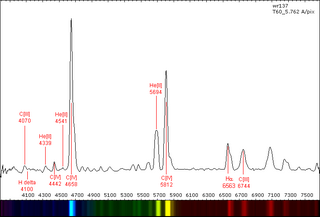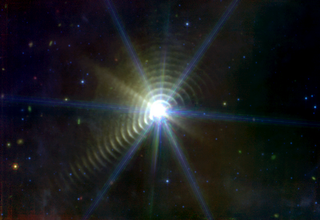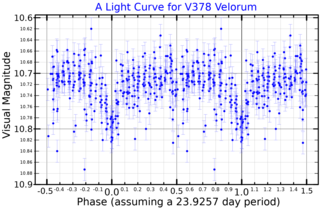
Zeta Cygni is a binary star system in the northern constellation of Cygnus, the swan. It has an apparent visual magnitude of 3.26 and, based upon parallax measurements, is about 143 light-years away.

HD 5980 is a multiple star system on the outskirts of NGC 346 in the Small Magellanic Cloud (SMC) and is one of the brightest stars in the SMC.

WR 22, also known as V429 Carinae or HR 4188, is an eclipsing binary star system in the constellation Carina. The system contains a Wolf-Rayet (WR) star that is one of the most massive and most luminous stars known, and is also a bright X-ray source due to colliding winds with a less massive O class companion. Its eclipsing nature and apparent magnitude make it very useful for constraining the properties of luminous hydrogen-rich WR stars.

WR 148 is a spectroscopic binary in the constellation Cygnus. The primary star is a Wolf–Rayet star and one of the most luminous stars known. The secondary has been suspected of being a stellar-mass black hole but may be a class O main sequence star.

HD 142527 is a binary star system in the constellation of Lupus. The primary star belongs to the Herbig Ae/Be star class, while the companion, discovered in 2012, is a red dwarf star or accreting protoplanet with a projected separation of less than 0.1″. The system is notable for its circumbinary protoplanetary disk and its discovery has helped refine models of planet formation. The orbit of companion is strongly inclined to the circumbinary protoplanetary disk.

DD Microscopii, also known as CD−43°14304, is a binary star system in the constellation Microscopium. The system has a combined average apparent magnitude around 11, making it readily visible in telescopes but not to the naked eye. It is thought to be at a distance of one or two thousand parsecs, although parallax measurements place the system at a distance of around 30,000 light years.

WR 30a is a massive spectroscopic binary in the constellation Carina. The primary is an extremely rare star on the WO oxygen sequence and the secondary a massive class O star. It appears near the Carina Nebula but is much further away.

WR 137 is a variable Wolf-Rayet star located around 6,000 light years away from Earth in the constellation of Cygnus.

WR 140 is a visually moderately bright Wolf-Rayet star placed within the spectroscopic binary star, SBC9 1232, whose primary star is an evolved spectral class O4-5 star. It is located in the constellation of Cygnus, lying in the sky at the centre of the triangle formed by Deneb, γ Cygni and δ Cygni.

WR 12 is a spectroscopic binary in the constellation Vela. It is an eclipsing binary consisting of a Wolf-Rayet star and a luminous companion of unknown spectral type. The primary is one of the most luminous stars known.

WR 9 is a spectroscopic binary in the constellation Puppis consisting of a Wolf-Rayet star and a class O star. It is around 12,000 light years away.

HD 151932, also known as WR 78, is a Wolf-Rayet star located in the constellation Scorpius, close to the galactic plane. Its distance is around 1,300 parsecs away from the Earth. Despite being a blue-colored Wolf-Rayet star, it is extremely reddened by interstellar extinction, so its apparent magnitude is brighter for longer-wavelength passbands. HD 151932 lies about 22′ west of the open cluster NGC 6231, the center of the OB association Scorpius OB1; it is not clear whether it is a part of the association or not. With an apparent magnitude of about 6.5, it is one of the few Wolf-Rayet stars that can be seen with the naked eye.
HD 136138, or HR 5692, is a binary star system in the Serpens Caput segment of the Serpens constellation. It has a golden hue like the Sun and is dimly visible to the naked eye with an apparent visual magnitude of 5.68; the light contribution from the companion is effectively negligible. This system is located at a distance of approximately 420 light years from the Sun based on parallax. It is drifting closer with a radial velocity of −7.7 km/s and has a proper motion of 23.5 mas·yr−1.

WR 133 is a visually moderately bright Wolf-Rayet star. It is a spectroscopic binary system containing a Wolf-Rayet primary and a class O supergiant secondary. It is in the constellation of Cygnus, lying in the sky at the centre of the triangle formed by β and γ Cygni, near η Cygni. It is the brightest member of the sparse open cluster NGC 6871.

AO Serpentis is an eclipsing binary star system in the Serpens Caput segment of the Serpens constellation. It is invisible to the naked eye with a typical apparent visual magnitude of 11.04. Variable star observers record a peak magnitude of 10.7, dropping to 12.0 during the primary eclipse and 10.8 from the secondary eclipse. The distance to this system is approximately 1,450 light years based on parallax measurements.

HD 150193 is a binary star system in the constellation of Ophiuchus. The primary star was identified as a Herbig Ae/Be star with a strong solar wind, losing approximately a tenth of solar mass per million years. It does host a very small debris disk, likely due to disk truncation by the nearby stellar companion. The disk is inclined 38±9° to the plane of sky. It appears to be highly evolved and asymmetric, with indications of flattening and grains growth.

WR 120 is a binary containing two Wolf-Rayet stars in the constellation of Scutum, around 10,000 light years away. The primary is a hydrogen-free weak-lined WN7 star, the secondary is a hydrogen-free WN3 or 4 star, and the system is a possible member of the cluster Dolidze 33. From our point of view, WR 120 is reddened by 4.82 magnitudes, and it has the variable designation of V462 Scuti.

HD 165590 is a quintuple system dominated by the binary Algol variable star known as V772 Herculis. The system lies in the constellation of Hercules about 123 light years from the Sun, and is suspected to be a part of the Pleiades moving group.

EQ Tauri is a triple star system in the equatorial constellation of Taurus that includes a contact eclipsing binary. The system is too faint to be viewed with the naked eye, having a baseline apparent visual magnitude of 10.5. During the primary eclipse, the brightness of the system drops to magnitude 11.03, then to 10.97 during the secondary minimum. The secondary eclipse is total. Based on parallax measurements, it is located at a distance of approximately 730 light years from the Sun.

RS Sagittarii is an eclipsing binary star system in the southern constellation of Sagittarius, abbreviated RS Sgr. It is a double-lined spectroscopic binary with an orbital period of 2.416 days, indicating that the components are too close to each other to be individually resolved. The system has a combined apparent visual magnitude of 6.01, which is bright enough to be faintly visible to the naked eye. During the primary eclipse the brightness drops to magnitude 6.97, while the secondary eclipse is of magnitude 6.28. The distance to this system is approximately 1,420 light years based on parallax measurements.





















